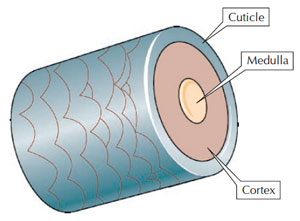The surface of the skin is virtually completely covered by invaginations of the epidermis, known as hair follicles. An invagination can be described as the folding of something so that an external surface becomes an internal surface. Thus in the case of the epidermis, the surface of a hair follicle is covered in the same cells as the surface of the external skin. Out of the follicle a keratin tube grows known as hair. The only parts of the skin surface that are not covered in hair are the lips, the palms of the hands and the soles of the feet – these parts of the skin are described as glabrous. For our early ancestors hair was vital for protection and for insulation. Now, as we have evolved into relatively hair-free beings, hair is much more about display, representation of cultural norms and sexual attraction. Hair does still offer some element of insulation and protection for the scalp, but clothing now provides most of the warmth and protection for the body.
Hair growth Hair growth occurs in three phases. The active growth phase, known as anagen, is usually about 3 years for head hair (although it can be up to 9 years – see later). This allows the hair on the head to grow to some considerable length; pubic and eyebrow hair have shorter growth phases (usually around a month). This means they fall out before they get very long. The resting phase, known as catagen, is when the hair sits in the follicle but is not actively growing and is followed by telogen when the hair is shed. It is normal for an individual to shed 70–80 hairs a day. When removing terminal hairs by plucking or waxing, the phase that the hair is in will effect, how hard the hair is to remove and how long it will take to grow back. Thus if the hair is in catagen or telogen it will come out relatively easily, but the growth phase starts again relatively quickly. If the hair is plucked during anagen, it is harder to remove but will take longer to grow back.
Types of hair There are three different types of hair, terminal, vellus and lanugo. Lanugo hairs are present in utero but are shed in early childhood. Vellus hairs are the fine downy hairs that cover most of the body, particularly in women and children. Terminal hairs are generally much coarser and thicker and include those which cover the scalp, beard, chest hair and pubic areas. The quantity and texture of hair is determined largely by genetic make-up, but hormonal changes can also influence hair growth and hair loss.
Terminal hair shape varies depending on the ethnic origin of an individual. In terms of hair type, three ethnic groups can be considered: black (Afro-Caribbean), Caucasian and Indo-Chinese.
- Afro-Caribbean: when cut in cross-section, the hair is thin and a flattish oval in shape. The hair is twisted and curly causing it to be come easily tangled and broken. The pigments within black hair are a combination of black and red, with around 40% of black women having near black hair, 50% black/brown hair and around 10% having auburn shades.
- Caucasian: a cross-section shows a slightly fatter oval shape than for black hair, generally being fine textured and varying from wavy to straight. It is the only ethnic group with a wide variety of pigment varying from white blonde to reds to black.
- Indo-Chinese: the cross-section shows an almost perfectly round shape and the hair is generally straight or very slightly wavy. It is a very strong type of hair with a great capacity for growth. The anagen phase can be twice as long as that of other hair types and the shedding rates less. This means that head hair can grow to the waist or below (Kingsley, 2003).
|
Figure 2.6 Structure of a hair. (Source: Reprinted
from Graham-Brown and Burns, 2006.) |
The basic structure of the hair is the same regardless of ethnic variations. It starts growth from the dermal papilla at the base of the hair shaft, where the keratinocytes divide, differentiate and gradually keratinise as the hair grows up the hair follicle. The hair bulb also contains melanocytes which will determine the pigment of the hair. Each hair consists of three distinct layers (Figure 2.6). The medulla running through the centre of the hair shaft consists of cells in which air is incorporated. The cortex is similar to the prickle cell layer of the skin, although keratinisation is further advanced. This is where the colour of the hair lies. The outer layer, or cuticle, is made up of overlapping keratinised plates, like tiles on a roof. The cuticle helps individual strands of hair to stay separate and not to matt together. Where the hair is subject to the greatest abrasion (at the tip), the cuticle may wear away allowing the keratin fibrils of the cortex and medulla to frizz out leading to split ends. Conditioners smooth the roughened surface of the cuticle helping the hair to look shinier. The structure of the hair is very strong and can stretch to up to 30% of its length.
